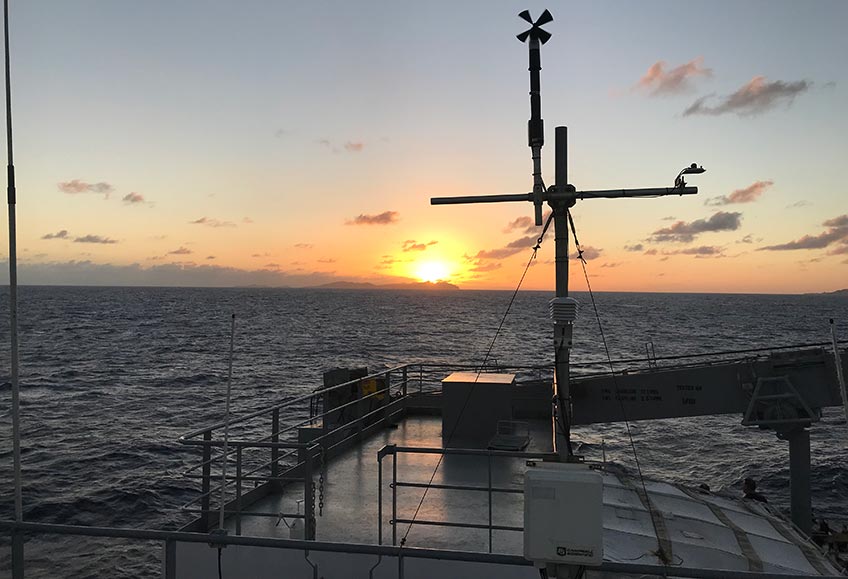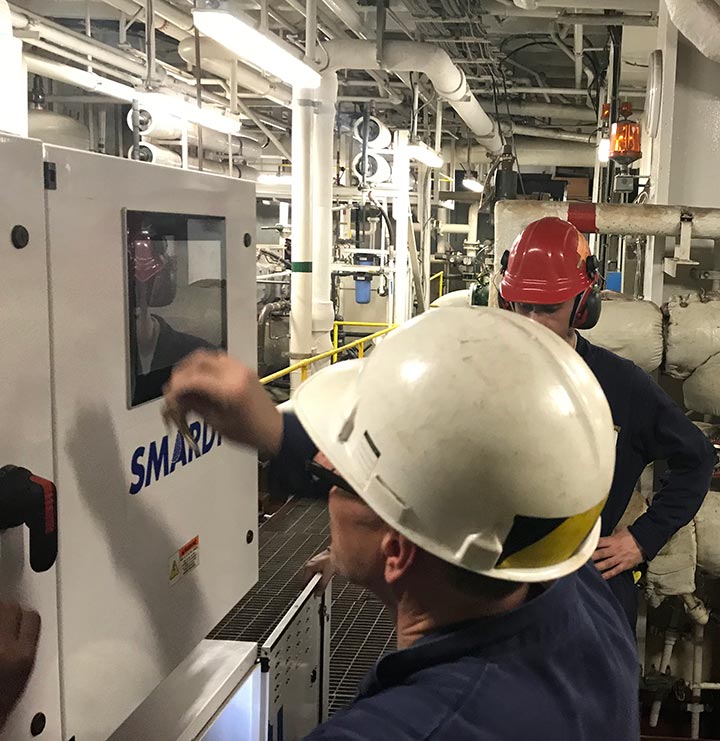Partnership With U.S. Navy Works To Save Fuel for Ships
NREL, in partnership with the Naval Surface Warfare Center Carderock and the U.S. Department of Transportation’s Maritime Administration, launched the Maritime Prescreening Assessment of Conservation Technologies (M-PACT) initiative.
M-PACT is designed to help the U.S. Navy save fuel through the testing and application of common energy efficiency technologies in the maritime environment.
Saving fuel allows Navy ships to stay on station longer and has the operational benefit of reducing the length and number of refueling evolutions. Refueling warships can also interfere with missions and is made difficult and more dangerous in bad weather. In short, fuel economy translates to operational flexibility.
Through the innovative, multi-year initiative, in the first iteration the M-PACT team took proven buildings technologies and applied them to ships. They used an NREL-enhanced version of EnergyPlus, the flagship U.S. Department of Energy program for modeling building energy, to measure their effectiveness and extrapolate meaningful results. EnergyPlus is a free, open-source, mature, thermophysical simulation program that researchers have used for more than two decades.
Buildings Technologies at Sea
EnergyPlus is a whole building energy simulation program that engineers, architects, and researchers use to model both energy consumption—for heating, cooling, ventilation, lighting, and plug and process loads—and water use in buildings.
To measure the effectiveness of the energy applications on ships, NREL researchers needed to make modifications to EnergyPlus. Although its merit has been widely publicized on land, it was not originally outfitted to work in a maritime environment or on mobile platforms. EnergyPlus allows the team to measure a small sample of a demonstration project and scale it up to see how the technology would perform across a larger section of a ship or, in some cases, the entire ship for longer periods of time—both while at sea and in port.

A sunset view from aboard the training ship Kennedy. Photo by Daniel Studer, NREL
For operational reasons, the Navy was hesitant to allow testing onboard an active combat ship, so the team used the training ship Kennedy, stationed at the Massachusetts Maritime Academy for cadet training. The team developed an energy model of a prescribed area of the ship and compared its performance to measured results obtained from 235 sensor points.
M-PACT was developed in phases, beginning in 2015. Each phase required a sea trial, and the training ship used for the project only went to sea once a year, so the team had a fixed amount of time to get the equipment ready and installed. The team evaluated the accuracy of the modified version of EnergyPlus by comparing results to direct measurements taken over a six-week underway period onboard the Kennedy.
The purpose of the first demonstration was to verify the modifications to EnergyPlus. The first cruise was smooth sailing, and the modifications worked as expected—the results were published in Naval Engineers Journal. The second cruise focused on monitoring the performance of a variable refrigerant flow system. Variable refrigerant flow is a type of heating, ventilation, and air conditioning system that circulates refrigerant to various fan coil units instead of conditioning air centrally and then circulating the conditioned air.

Cadets work on a magnetic bearing chiller. Photo by Daniel Studer, NREL.
"We saw significant savings," NREL engineer Danny Studer said. "We essentially ran on/off testing and used the data to extrapolate what the system would have done over the whole voyage and what it would have done parked at its home port for a year."
There were worries initially about how the refrigerant lines themselves would hold up, but the team did not experience any issues. Studer said the crew loved it. It was much quieter, more energy-efficient, and maintained better space temperatures than the existing system.
The latest cruise focused on the demonstration of a magnetic bearing chiller. Magnetic bearings replaced conventional oil-lubricated bearings to eliminate high friction losses, mechanical wear, and high-maintenance oil management systems to deliver chiller energy savings. For a ship, all of this points to fuel savings.
The Results and Future Studies
By March 2020, the team had collected all the data required to support the magnetic bearing chiller analysis. However, funding for the initiative, originally set up through memorandums of understanding and interagency agreements, was depleted, and the team still needed to run the simulations. The Navy is seeking additional funding to complete the magnetic bearing chiller simulation as well as an additional study to measure the effectiveness of low solar absorbing paint.
For the next study, the team is discussing a low solar absorbing paint demo, which would include the modeling of the entire ship. The paint will absorb less heat from the sun, and when applied to the freeboard and topside areas of the ships, will transfer less heat and reduce the cooling load. This means the Navy could spend less energy cooling the ship, and that translates to saved fuel, increased efficiency, and fewer operational risks. Understanding whether the energy benefit outweighs the installation costs, and in which operational theaters, however, is where NREL comes in.
Results from the M-PACT initiative so far are broader than the potential follow-on work with the Navy. The modifications made to EnergyPlus enabled the Department of Energy's Water Power Technologies Office to assess its wave conversion buoy prototypes in new ways. The Water Power Technologies Office asked the team to evaluate the design of a new wave conversion buoy, which was expected to have a significant amount of electronics onboard. The concern was that those components would overheat and damage the electronics unless additional cooling systems were installed. The spaces are not actively ventilated, and in environments such as Hawaii where the air and water are warm, the concern is elevated. The team was able to provide guidance to keep those spaces at a temperature that would allow the electronics to continue functioning. The analysis piece was straightforward, but without the modifications the team made to EnergyPlus through M-PACT, calculations with sea water would not have been possible.
The mission of the Navy is to maintain, train, and equip combat-ready naval forces capable of winning wars, deterring aggression, and maintaining freedom of the seas. The Navy is better positioned to accomplish its mission with ships that can stay at sea longer while minimizing the need for challenging, and sometimes risky, refuelings. From the modifications made to the Kennedy, the M-PACT team saw significant fuel savings that could someday translate to applications on Navy ships.
M-PACT demonstrates an innovative approach to using commercial technologies (proven in building environments) to improve energy efficiency and operational capabilities of ships in port or at sea. As an organization focused on innovation, NREL seeks to leverage these types of opportunities for the Navy, Department of Defense, and all of our government, industry, research, and nonprofit partners.
Partner With Us
Share
Last Updated March 25, 2025
